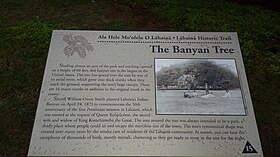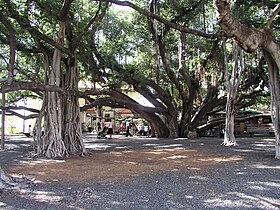Banyan Tree In Lahaina
The 2023 Hawaii wildfires destroyed the town of Lahaina and severely damaged the tree. Disaster recovery efforts took place to determine the scope of the damage and to determine if the tree could be salvaged and restored. After fully examining the tree, arborists believe it has a reasonable chance of regeneration. To improve its chances, they have implemented a regimen of irrigation, compost, and soil aeration, with results expected in three to six months.
History
The banyan tree is located close to the port in the historical Lahaina town, which was the former capital of Hawaii. It is the oldest banyan tree in Hawaii.
The banyan tree, received as a gift by the Smith family in the 1870s, was planted on April 24, 1873, at Lahaina by William Owen Smith, the then sheriff of Lahaina. The tree was planted to mark the 50th anniversary of the arrival of the first Protestant mission in Maui; the mission had been invited to Maui by Queen Keōpūolani, wife of late King Kamehameha. Its extensive trunk and aerial root system covered 0.66 acres (0.27 ha), located in the Courthouse Square, which is renamed as the Banyan Tree Park covering 1.94 acres. It is not only the largest in Hawaii but also in the United States. The park is managed by the County of Maui and the Lahaina Restoration Foundation.
According to reports a royal ball was held under the tree in 1886 for King Kamehameha III on his birthday.
The Aloha Festivals Week has been held under this tree. The shade of the tree was used to shade vendors who held events approximately 36 weekends per year. At sunset, there was a riot of noise as the birds flew back into the tree to find the best branch to sleep on. There used to be a canal of water down one side of the tree, and even though the canal is now a street, it is still thought to be a source of water for the tree roots.
Aerial roots help support the tree's huge limbs. To encourage the roots to reach the ground faster, there were mayonnaise jars filled with water and tied to hang just below the roots. The roots wanted the water and it was thought that they did grow faster. Despite it appearing as many trees, it is actually one tree with many limbs that have grown new trunks beneath them.
2023 wildfire and rehabilitation

The tree was seriously damaged when a series of wildfires broke out on the island of Maui in early August 2023. The wind-driven fires prompted evacuations, caused widespread damage, and killed nearly a hundred people in the town of Lahaina. The proliferation of the wildfires was attributed to dry, gusty conditions created by a strong high-pressure area north of Hawaii and Hurricane Dora to the south.
Consulting Arborist Steve Nimz is monitoring the burned tree for signs of rehabilitation and renewed health. After the wildfire, a full inspection of the tree was completed, comprising the aerial roots and beneath the bark. Nimz discovered that the main trunks have live tissue, which is considered a good indicator of regeneration. He expects the wait and see period to last anywhere from three to six months. Current restoration efforts include a daily watering program provided by water trucks with hoses, and the addition of a two-inch layer of compost and soil aeration. "Normally if you touch or cut into a banyan tree, you’re just going to see that sap oozing out really fast," Nimz told The Maui News. "There was sap where I cut in on the top and all these areas, but it wasn’t proliferous like it would be on a really healthy tree. But it’s there. What I am saying is that these trees are resilient. With everybody’s love and everybody here, we want to see the tree make it. It’s up to the tree right now."
On September 19, the Hawaii Department of Land and Natural Resources reported a fresh sprout of leaves out of the tree, indicating the first signs of possible recovery. In November 2023 it was reported by arborists that while part of the tree only had high heat from the flames, which killed the leaves and not the branches or trunk about 15-20% of the tree was too badly burned and would need to be trimmed back. Stepping stones around the base of the tree were removed to allow more nutrients to penetrate the soil and fifteen solar powered sensors were attached to the tree in order to monitor it.
In March 2024, roughly a third of the tree was removed. These dead portions were removed in order to encourage the tree to redirect its healing efforts towards the portions of the tree that were recovering. In addition, efforts were underway to eventually restore the original footprint of the tree via air layering.
Features
The banyan tree or Ficus benghalensis is from India, and it is known for unusual growth of its roots. The roots descend or sprout from the branches into aerial roots towards the ground where they form new trunks. This results in the growth of many trunks around the main trunk. The banyan, native to India, is one of 60 types (out of reported 1,000 species in the world) of fig trees found throughout Hawaii. The trees are tall and “grow into mazes of additional trunks” and in Lahaina the tree covers an area of over half an acre. The banyan tree in Lahaina, when planted, was a sapling of 8 feet (2.4 m) height. Over the years it has grown to a height of over 60 feet (18 m) and spread into 16 major trunks, apart from the main trunk forming a large canopy of providing shade to the people from the blazing sun of Lahaina; it was intended as a part of a park. The growth of the roots was facilitated by the local Japanese gardening community, by hanging lanterns filled with water at suitable aerial roots. It is one of the sixty fig tree species in Hawaii and is said to be the largest tree both in Hawaii and in the United States. It has a circumference of about one-fourth of a mile, and about a thousand people could congregate under it. A sight to watch at dusk time is the congregation of birds such as common myna birds (Acridotheres tristis) which roost in the branches of the tree for the night causing a cacophony of bird cries.
Conservation
The tree has been subject to severe stress due to drought conditions, soil compaction from foot and vehicle traffic in the park, and also due to developmental activities in the vicinity. As a result, restrictions have been imposed on plying vehicles under the tree. Its sustenance has been ensured by the Lahaina Restoration Foundation by installing an irrigation system in the park.
Gallery
-
A plaque giving details of the tree
-
The main trunk of the banyan tree
-
The main trunk of the banyan tree at Lahaina
-
The banyan tree in Lahaina spread over 0.66 acre of land
-
Banyan Tree in Lahaina
-
Graffiti on the trunks of the tree
See also
References
- ^ Parker, Jordan (August 9, 2023). "Maui's famous banyan tree scorched in fire. Will it survive?". San Francisco Chronicle. Archived from the original on August 10, 2023. Retrieved August 10, 2023.
- ^ Anguiano, Dani (August 10, 2023). "'Heartbeat of Lahaina Town': wildfire chars beloved 150-year-old banyan tree". The Guardian. Archived from the original on August 10, 2023. Retrieved August 10, 2023.
- ^ "Lahaina Banyan Court". County of Maui. Archived from the original on 2014-11-10. Retrieved 2014-11-17.
- ^ "The Lahaina Banyan Tree How It Came To Be". Lahaina Restoration Foundation. Archived from the original on 2014-11-29. Retrieved 2014-11-17.
- ^ Legarde & Foster 1996, p. 171.
- ^ Kevin Whitton (15 August 2014). Hawaiian Islands. Avalon Travel Publishing. pp. 265–. ISBN 978-1-61238-831-1.
- ^ Julie DeMello (2 December 2008). Hawaii: Hundreds of Ideas for Day Trips with the Kids. Globe Pequot Press. pp. 60–. ISBN 978-0-7627-4859-4.
- ^ Timothy Hurley (22 April 2001). "There's life yet in the old banyan tree". WebCite. Archived from the original on July 17, 2001.
- ^ "Hope Is Hard to Let Go After Maui Fire As Odds Wane over Reuniting with Still Missing Loved Ones". www.wdtn.com. Retrieved 21 August 2023.
- ^ "Lahaina's Historic Banyan Tree Is Scarred, but Standing". 2023-08-10. Archived from the original on 2023-08-15. Retrieved 2023-08-16.
- ^ KITV Web Staff (August 14, 2023). "Esteemed arborist Steve Nimz gives update on Lahaina's Banyan tree". KITV. Archived from the original on 2023-08-16. Retrieved 2023-08-15.
- ^ Wu, Nina (August 15, 2023). "Efforts underway to revive 150-year-old banyan tree in Lahaina". Honolulu Star-Advertiser. Retrieved August 15, 2023.
- ^ Uechi, Colleen (August 14, 2023). "On the ground in Lahaina town: Sadness, searching, signs of hope". The Maui News. Archived from the original on 2023-08-14. Retrieved 2023-08-15.
- ^ "Lahaina's historic banyan tree sprouts first new leaves since wildfires". NBC News. 2023-09-19. Retrieved 2023-09-20.
- ^ Quan, Rick (2023-11-13). "Maui Resilience: Lahaina's iconic tree emerges from wildfire, faces 20% loss". KITV Island News. Retrieved 2024-01-08.
- ^ Thayer, Matthew (March 9, 2024). "Fire-ravaged banyan receives major trim". The Maui News. Archived from the original on 2024-03-09. Retrieved 2024-04-06.
- ^ a roving printer (1861). life and adventure in the south pacific.
- ^ Scott 1991, p. 53.
- ^ "Lahaina Historic Trail, The Banyan Tree". Archived from the original on 2014-12-20. Retrieved 2014-11-17.
Bibliography
- Legarde, Lisa; Foster, Jeanette (1996). Frommer's Maui, with the Best Beaches, Shopping and Dining. John Wiley & Sons, Incorporated. ISBN 978-0-02-860905-8.
- Scott, Susan (1 January 1991). Plants and Animals of Hawaii. Bess Press. p. 53. ISBN 978-0-935848-93-9.





